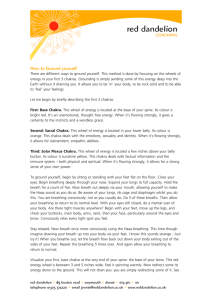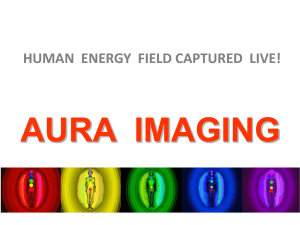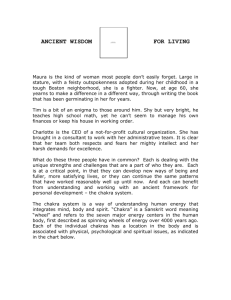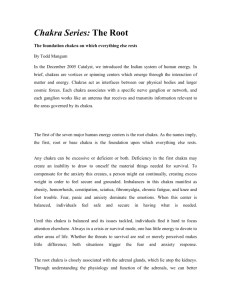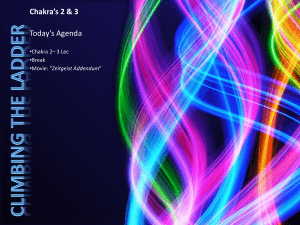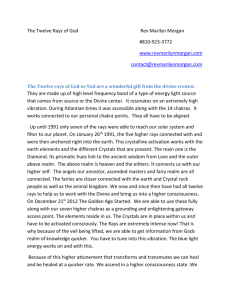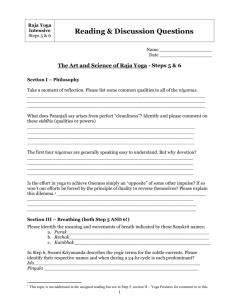Special Series: The Chakra System: Reclaiming the Caduceus
advertisement
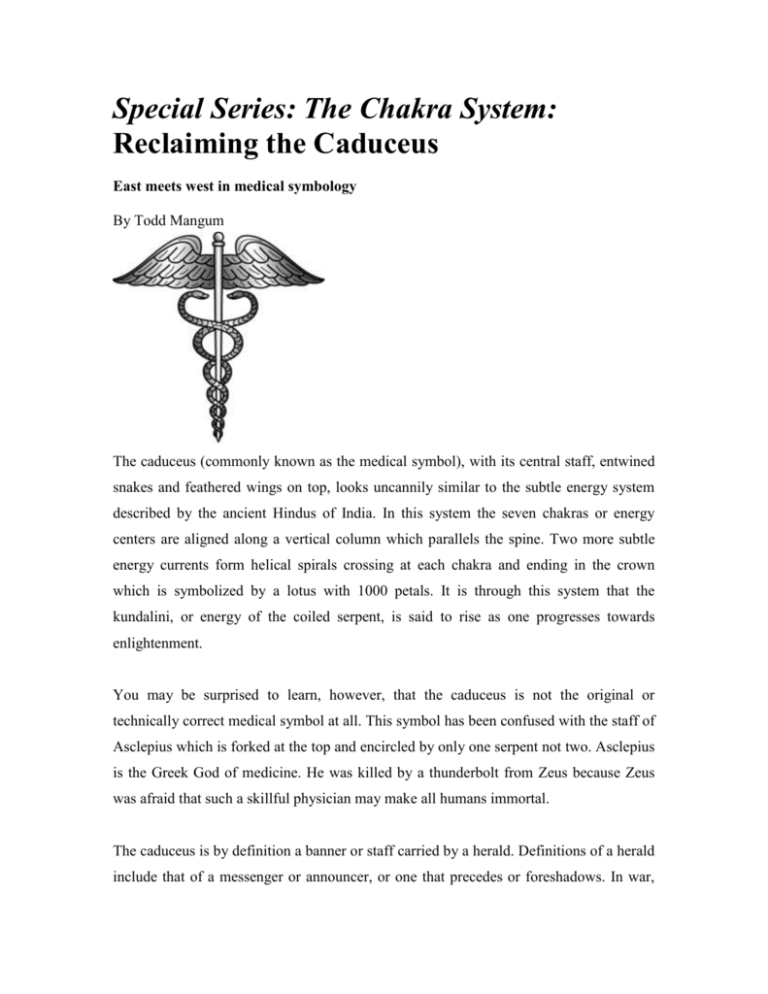
Special Series: The Chakra System: Reclaiming the Caduceus East meets west in medical symbology By Todd Mangum The caduceus (commonly known as the medical symbol), with its central staff, entwined snakes and feathered wings on top, looks uncannily similar to the subtle energy system described by the ancient Hindus of India. In this system the seven chakras or energy centers are aligned along a vertical column which parallels the spine. Two more subtle energy currents form helical spirals crossing at each chakra and ending in the crown which is symbolized by a lotus with 1000 petals. It is through this system that the kundalini, or energy of the coiled serpent, is said to rise as one progresses towards enlightenment. You may be surprised to learn, however, that the caduceus is not the original or technically correct medical symbol at all. This symbol has been confused with the staff of Asclepius which is forked at the top and encircled by only one serpent not two. Asclepius is the Greek God of medicine. He was killed by a thunderbolt from Zeus because Zeus was afraid that such a skillful physician may make all humans immortal. The caduceus is by definition a banner or staff carried by a herald. Definitions of a herald include that of a messenger or announcer, or one that precedes or foreshadows. In war, the caduceus was often carried as a banner of peace and conferred immunity from harm on the one who carried it. This symbol's correct association is as the staff of Hermes, messenger of the Gods. It originally had little or nothing to do with medicine. Like all symbols, the caduceus is rich with meaning and layered with interpretation. Symbols often have a life of their own; like all living things, they grow, evolve and change through time. Studying symbols can uncover their history and origins and illuminate their present meaning. Meditating upon them, however, may reveal secrets lying dormant within like germinal seeds waiting to birth the next generation. Whether by mistake or design, the appropriation of the caduceus as a medical symbol at the deepest level may not be one of confusion, but instead one of clarification-perhaps a premonition. The staff of Asclepius may symbolize Western medicine's past. With its singular serpent, it strongly portrays Western medicine's unbalanced approach to health. When fully understood and illuminated, however, the caduceus tells where medicine is heading. With its symmetrical serpents, it heralds, for all those willing to see, an emerging paradigm of balance-one which unifies East and West, spirit and matter, intuition and logic, and one that is allowing an organic philosophy to infuse our overly mechanical one. In future months we will journey through human energy and endocrine anatomy using the symbol of the caduceus, interwoven with the chakras, as a map. The chakras are a metaphysical system that diagrams the interfaces and interrelationships between the various aspects of our multidimensional selves. The word chakra means spinning wheel or disk. In humans, the chakras represent the center's energy which composes our subtle anatomy. Chakras are vortices or energy centers which act as interfaces between our physical bodies and larger cosmic forces. The chakras emerge from the interaction of matter and energy much like a whirlpool emerges in a drain from the interaction of the water and the force created by the spinning earth. They could also be seen to emerge in the way the energy of sunlight interacts with the matter in a prism to form a rainbow. The chakras act as transformers between the opposing forces or energy currents of manifestation and liberation, modulating the frequencies of each, making slower and denser with each step the downward manifesting current and faster and more rarefied the upward liberating one. A blockage in any of the chakras may result in an inability to either expand our consciousness or to manifest our desires. Each chakra has a specific nerve ganglion or network associated with it. These ganglia could be seen as antennae which receive and transmit information relevant to the areas governed by each specific chakra. Each one of the seven major centers of the body have multiple associations, from the purely physical, such as endocrine glands and nerve ganglia, to various emotional realms and states of conscious awareness. Each also has a specific color, sound, element and food. Anodea Judith, whose excellent books elaborate extensively on the chakras, describes them as computer disks that contain programming about how to handle various aspects of our lives. These disks in turn interface with the hardware of our physical bodies and result in our experiences of the physical, emotional, mental and spiritual worlds. She describes a basic "program" for each center. I will use her work as a template upon which to build, adding more specific and practical medical information especially as it applies to endocrine or hormonal system from the adrenals on up to the hypothalamus. I encourage all those interested in more in depth study to purchase her books, "Wheels of Life" and "The Sevenfold Journey." As with any system this old, there are many interpretations as to exactly what characteristics and anatomical parts belong to any given chakra. In comparing diverse systems, no two correlate exactly. For instance, it is impossible to superimpose the concept of the liver and kidney energetic networks of Chinese Medicine upon the organs of the same names in Western medicine. They speak two very different languages and absolute translations lead to miscommunications. The same holds true when comparing glandular anatomy and the chakric system. Although many have assigned one gland to one chakra, this doesn't always quite fit and leads to variations found from one description to another. Although these systems do overlap, trying to squeeze one completely into another harms them both. It is often the difference between thinking anatomically as opposed to energetically. Both are correct. What is given below is a guideline, not gospel, about some of the associations. THE CHAKRA SYSTEM CHAKRA ONE is located near the base of the spine, in the perineum. It is defined as the chakra that governs understanding of the physical world. Its main issue is survival and is the center through which we experience the "flight or fight" response. It externalizes as the adrenal gland especially as it concerns the adrenal medulla and its production of adrenaline or epinephrine. The adrenal gland also has associations with chakra 2 and 3. Its element is Earth. When it is balanced, we feel grounded. Its color is a harmonic of RED. CHAKRA TWO is located in the pelvis. It governs our sexuality and desires. Its main issue involves our ability to experience pleasure and sensation. It externalizes as the ovaries in women and the testicles in men. Its element is water. When it is balanced we feel sensuous. Its color is a harmonic of ORANGE. CHAKRA THREE is located in the solar plexus or upper abdomen. It governs our production and utilization of energy especially in relation to sugar metabolism and digestion of food. Its main issue involves our personal power or will. It externalizes mainly as the pancreas but also the as the adrenal cortex. Along with chakra one it regulates our ability to cope with stress. Its element is fire. When it is balanced we feel powerful. Its color is a harmonic of YELLOW. CHAKRA FOUR is the heart chakra and is located in the center of the chest. It governs our immunity. Its main issue involves our ability to feel self acceptance and unconditional love. It externalizes as the thymus gland. Its element is air. When it is balanced we feel compassionate. Its color is a harmonic of GREEN. CHAKRA FIVE is located in the throat. It governs our metabolism during activity and determines our resting metabolic rate. Its main issue is communication. It externalizes as both the thyroid and parathyroid glands. Its element is sound. When it is balanced we feel harmonious. Its color is a harmonic of BLUE. CHAKRA SIX is known as the third eye and is located between the eyebrows. It governs our circadian rhythms. Its main issue is intuition. It eternalizes as the pineal gland. Its element is light. When it is balanced we feel imaginative. Its color is a harmonic of INDIGO. CHAKRA SEVEN is located at the crown or top of the head. It governs the integration of the central nervous system with that of endocrine glands. Its main issue understands. It externalizes as the pituitary and hypothalamus glands. Its element is thought. When it is balanced we know. Its color is a harmonic of VIOLET. Todd Mangum, M.D., of the Web of Life Wellness Center, is a holistically oriented physician practicing in Salt Lake City.

